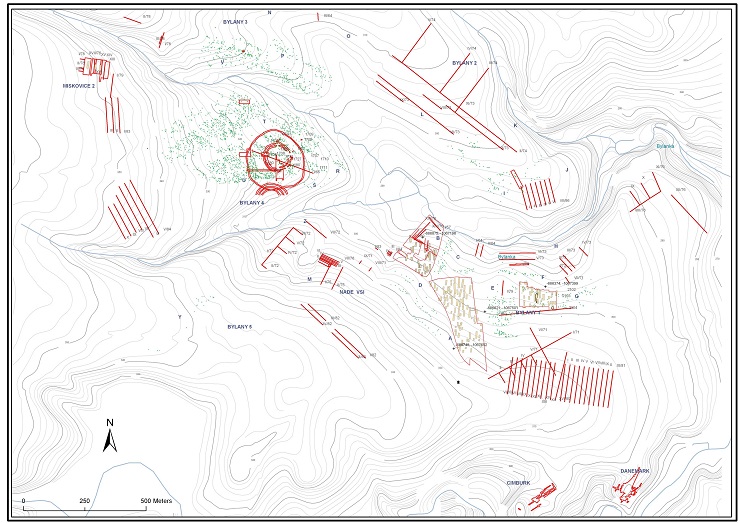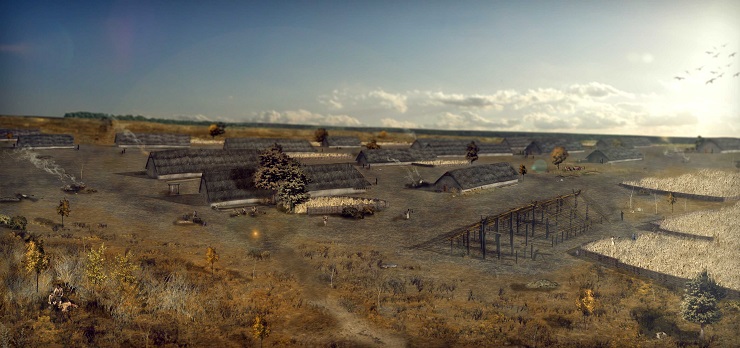The first agricultural population founded the settlement that functioned virtually continuously in the cadastral area of what today is Bylany, close to Kutná Hora, though with fluctuations of various sizes, for five centuries until the end of the Linear Pottery culture, i.e. until the end of the 6th millennium BC. After a hiatus of cca. three hundred years a Late Neolithic settlement reappeared there, representing the Stroked Pottery culture (STK), and in addition to the actual settlement it also left such traces there as a burial site and two roundels.
The Neolithic settlement in Bylany represents a model example of a place that has been inhabited over the long-term in which it is possible to have the advantage of being able to study the evolution of this society of early farmers, including the nature of their lives. During the research seasons more than seven hectares were unearthed on which almost 150 longhouses of the Linear Pottery culture (LBK) were identified, together with their accompanying facilities. Despite the considerable efforts of researchers no LBK necropolis has ever been discovered there, even though elsewhere during this period they were common enough. The size of the Bylany settlement during its different chronological horizons varied in terms of the number of concurrent houses that existed. The number ranged from two to three dwellings existing simultaneously to a maximum number of eleven longhouses.
|
|
| A plan of the archaeological discoveries made in the residential area of Bylany, located near Kutná Hora. A virtual map can be viewed here: http://gisbylany.arup.cas.cz/GIS-Bylany/ |
The Bylany site, due to its innovative approach to large-scale terrain stripping and its statistical processing of the enormous amounts of data obtained, indelibly enrolled in this special methodology. It was Bohumil Soudský who deserved special merit in regard to the actual discovery of the Neolithic Bylany site and for initiating the research of it. This advanced researcher based the chronological system of the Linear Pottery culture on earlier findings and their critical evaluation and subsequently sought for a suitable reference site that would provide the possibility of the extensive and comprehensive uncovering of an Early Neolithic settlement. Soudský commenced his research in Bylany in 1953 and after obtaining the necessary authentication of the terrain he then proceeded to undertake annual campaigns with his team until 1967. Shortly thereafter, he left for the University in Saarbrücken and moved to Paris, where, after the Soviet occupation of his homeland, he then decided to stay.
However, regardless of Bohumil Soudský’s departure into exile, the Bylany research had not yet been completed. After his departure the research was taken over by Marie Zápotocká and Ivan Pavlů, who continued the systematic processing and its evaluation. During the period in which, as a result of changes to the Archaeological Institute’s concept in regard to the large-scale stripping in Bylany, the work was suspended, systematic prospecting of the surrounding areas was carried out through numerous surface collections or by means linear probing. Larger field excavations were resumed again briefly in the late 1970’s and again in the early 1990’s, when both a smaller settlement of the Linear Pottery culture and also a burial site of the Stroked pottery culture were uncovered in Miskovice.
|
|
| A hypothetical reconstruction of the peak period of the Bylany settlement. It has not yet been ascertained, however, which houses were inhabited and which had been abandoned nor whether the cultivated areas of the cereal gardens had really been right next to the houses. Author Petr Vavrečka. |
A base had been established right at the beginning of 1957 as a requisite back-up for the entire research project in Bylany. Processing the huge amount of material that was discovered - more than 70,000 potsherds and thousands of other artefacts and items - required rigorous coordination during its processing and automated evaluation using punched card technology. A description of the characteristics of the pottery was formalised and as one of the earliest times that computer science was utilised in regard to archaeology this enabled the implementation of a model of the local settlement. At the beginning there were colour phases (purple, orange, grey, etc.) that were introduced by Soudský. After determining the relative chronology these coloured sections were replaced by four numerically identified developmental stages, which were subsequently divided in even greater detail into 25 shorter stages in accordance with a quantitative evaluation of the features of linear decoration and then complemented with six additional longer time periods (intervals) in accordance with the trends of various artefacts. The actual exploration is still in operation, albeit as a mission that is based on different principles. The Bylany research heritage, however, still conceals the broad investigative potential that is waiting to be enriched by means of the technologies pertaining to the new millennium.
Want to learn more?
- Květina, P. – Končelová, M. 2013. Settlements patterns as seen in pottery decoration style: a case study from the early Neolithic site of Bylany (Czech Republic). The domestic space in LBK settlements. C. Hamon, P. Allard, M. Ilett and (Eds.). Nanterre, France, VML Verlag Marie Leidorf GmbH. Internationale Archäologie - Arbeitsgemeinschaft, Symposi: 99-110.
- Pavlů, I. 2000. Life on a neolithic site. Praha, ARU Praha.
- Pavlů, I. – Rulf, J. – Zápotocká, M. 1986. Theses on the Neolithic site of Bylany. Památky archeologické 77: 288-412.
- Pavlů, I. – Rulf, J. – Zápotocká, M. 1995. Bylany rondel. Model of the neolithic site. Památky archeologické Supplementum 3: 7-123.
- Rulf, J. ed. 1989. Bylany – seminar 1987. Collected papers. Praha, ARU Praha.
 Archeologické 3D virtuální muzeum
Archeologické 3D virtuální muzeum

.jpg)

